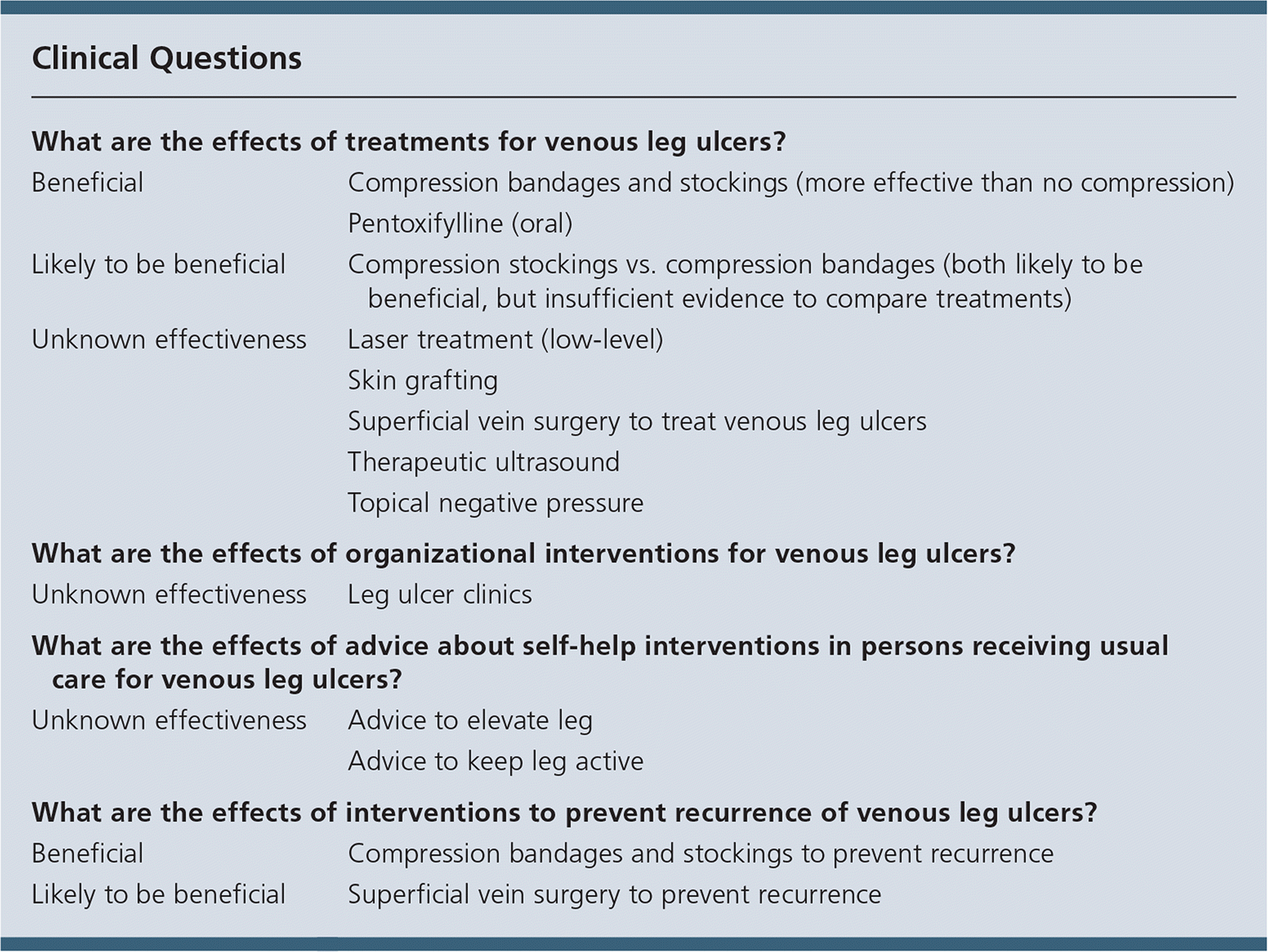
Am Fam Physician. 2017;95(10):662-663
Author disclosure: E. Andrea Nelson is the author of references cited in the overview. She was also an applicant in a trial for which Beiersdorf UK Ltd. provided trial-related education. Una Adderley declares she has no competing interests.
Leg ulcers are usually secondary to venous reflux or obstruction, but 20% of persons with leg ulcers have arterial disease, with or without venous disorders.
Compression bandages and stockings heal more ulcers compared with no compression, but we do not know which compression technique is most effective.
Compression is used for persons with ulcers caused by venous disease who have an adequate arterial supply to the foot.
The effectiveness of compression bandages depends on the skill of the person applying them.
Oral pentoxifylline increases ulcer healing in persons receiving compression.
We do not know whether therapeutic ultrasound, superficial vein surgery, skin grafting, leg ulcer clinics, laser treatment, or advice to elevate legs or increase activity increases healing of ulcers in persons treated with compression.
Compression bandages and stockings reduce recurrence of ulcers compared with no compression, and should ideally be worn for life.
Superficial vein surgery may also reduce recurrence.

| What are the effects of treatments for venous leg ulcers? | |
| Beneficial | Compression bandages and stockings (more effective than no compression) |
| Pentoxifylline (oral) | |
| Likely to be beneficial | Compression stockings vs. compression bandages (both likely to be beneficial, but insufficient evidence to compare treatments) |
| Unknown effectiveness | Laser treatment (low-level) |
| Skin grafting | |
| Superficial vein surgery to treat venous leg ulcers | |
| Therapeutic ultrasound | |
| Topical negative pressure | |
| What are the effects of organizational interventions for venous leg ulcers? | |
| Unknown effectiveness | Leg ulcer clinics |
| What are the effects of advice about self-help interventions in persons receiving usual care for venous leg ulcers? | |
| Unknown effectiveness | Advice to elevate leg |
| Advice to keep leg active | |
| What are the effects of interventions to prevent recurrence of venous leg ulcers? | |
| Beneficial | Compression bandages and stockings to prevent recurrence |
| Likely to be beneficial | Superficial vein surgery to prevent recurrence |
Definition
Definitions of leg ulcers vary, but the following is widely used: an open sore in the skin of the lower leg due to high pressure of the blood in the leg veins. Some definitions exclude ulcers confined to the foot, whereas others include ulcers on the whole of the lower limb. This overview addresses ulcers of venous origin in persons without concurrent arterial insufficiency.
Incidence and Prevalence
Between 1.5 and 3.0 per 1,000 persons have active leg ulcers. Prevalence increases with age to about 20 per 1,000 persons older than 80 years. Most leg ulcers are secondary to venous disease; other causes include arterial insufficiency, diabetes mellitus, and rheumatoid arthritis, or less commonly, autoimmune disease, cancer, or tropical disease. The annual cost to the National Health Service in the United Kingdom has been estimated at £300 million. This does not include the loss of productivity because of illness.
Etiology and Risk Factors
Leg ulceration is strongly associated with venous disease. However, about one-fifth of those with leg ulceration have arterial disease, alone or in combination with venous problems, which may require a subspecialist referral. Venous ulcers (also known as varicose or stasis ulcers) are caused by venous reflux or obstruction, both of which lead to poor venous return and venous hypertension.
Prognosis
Persons with leg ulcers have a poorer quality of life than age-matched controls because of pain, odor, and reduced mobility. In the United Kingdom, audits have found wide variation in the types of care (hospital inpatient care, hospital clinics, outpatient clinics, home visits), in the treatments used (topical agents, dressings, bandages, stockings), and in healing rates and recurrence rates for venous leg ulcers.
The authors would like to acknowledge June Jones, the previous contributor of this overview.
